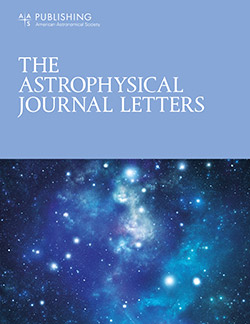小规模合并增长:JWST在0.5≤z≤3.0的大质量静止星系周围探测到微弱的蓝色伴星
IF 8.8
1区 物理与天体物理
Q1 ASTRONOMY & ASTROPHYSICS
引用次数: 1
摘要
小型合并被认为推动了大质量静止星系的结构演化;然而,现有的哈勃太空望远镜(HST)成像主要是对恒星质量比< 1:10敏感。在这里,我们报告了在已知的log M * / M⊙≥10.5的静止星系的35 kpc内发现了大量的低质量伴星,0.5≤z≤3。虽然像HST发现的大质量伴星很少,但JWST高级深河外巡天的成像显示,平均而言,大质量静止星系拥有大约5个恒星质量比为1:10的伴星。尽管恒星的中间质量比只有1:90,但这些微小的伴星数量如此之多,它们至少占了通过小型合并而增加到静止星系的总质量的30%。虽然质量相对较大的伴星的颜色与它们的宿主星系相似,但质量比为1:10的伴星通常比半径相似的宿主星系颜色更蓝,质量光比更低。这些小伴星的吸积很可能会推动宿主星系的颜色梯度和恒星种群特性的演变。我们的研究结果表明,静止星系的“小合并增长”模型可以扩展到非常低的质量比(约1:100),并证明了JWST在约束大质量星系和局部宇宙之外的低质量伴星的空间分辨特性方面的能力。本文章由计算机程序翻译,如有差异,请以英文原文为准。
Minor Merger Growth in Action: JWST Detects Faint Blue Companions around Massive Quiescent Galaxies at 0.5 ≤ z ≤ 3.0
Abstract Minor mergers are thought to drive the structural evolution of massive quiescent galaxies; however, existing Hubble Space Telescope (HST) imaging is primarily sensitive to stellar mass ratios ≳1:10. Here, we report the discovery of a large population of low-mass companions within 35 kpc of known log M * / M ⊙ ≳ 10.5 quiescent galaxies at 0.5 ≤ z ≤ 3. While massive companions like those identified by HST are rare, JWST imaging from the JWST Advanced Deep Extragalactic Survey reveals that the average massive quiescent galaxy hosts approximately five nearby companions with stellar mass ratios <1:10. Despite a median stellar mass ratio of just 1:900, these tiny companions are so numerous that they represent at least 30% of the total mass being added to quiescent galaxies via minor mergers. While relatively massive companions have colors similar to their hosts, companions with mass ratios <1:10 typically have bluer colors and lower mass-to-light ratios than their host galaxies at similar radii. The accretion of these tiny companions is likely to drive evolution in the color gradients and stellar population properties of the host galaxies. Our results suggest that the well-established “minor merger growth” model for quiescent galaxies extends down to very low mass ratios of ≲1:100, and demonstrates the power of JWST to constrain both the spatially resolved properties of massive galaxies and the properties of low-mass companions beyond the local Universe.
求助全文
通过发布文献求助,成功后即可免费获取论文全文。
去求助
来源期刊

Astrophysical Journal Letters
ASTRONOMY & ASTROPHYSICS-
CiteScore
14.10
自引率
6.30%
发文量
513
审稿时长
2-3 weeks
期刊介绍:
The Astrophysical Journal Letters (ApJL) is widely regarded as the foremost journal for swiftly disseminating groundbreaking astronomical research. It focuses on concise reports that highlight pivotal advancements in the field of astrophysics. By prioritizing timeliness and the generation of immediate interest among researchers, ApJL showcases articles featuring novel discoveries and critical findings that have a profound effect on the scientific community. Moreover, ApJL ensures that published articles are comprehensive in their scope, presenting context that can be readily comprehensible to scientists who may not possess expertise in the specific disciplines covered.
 求助内容:
求助内容: 应助结果提醒方式:
应助结果提醒方式:


